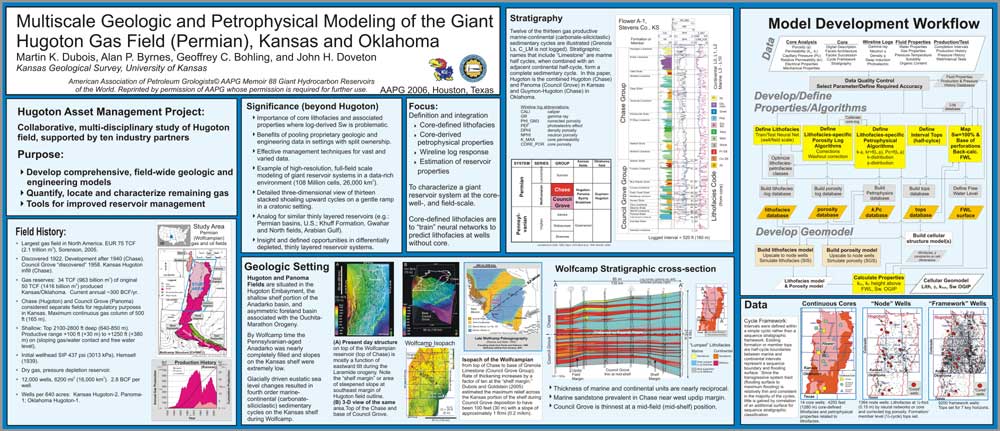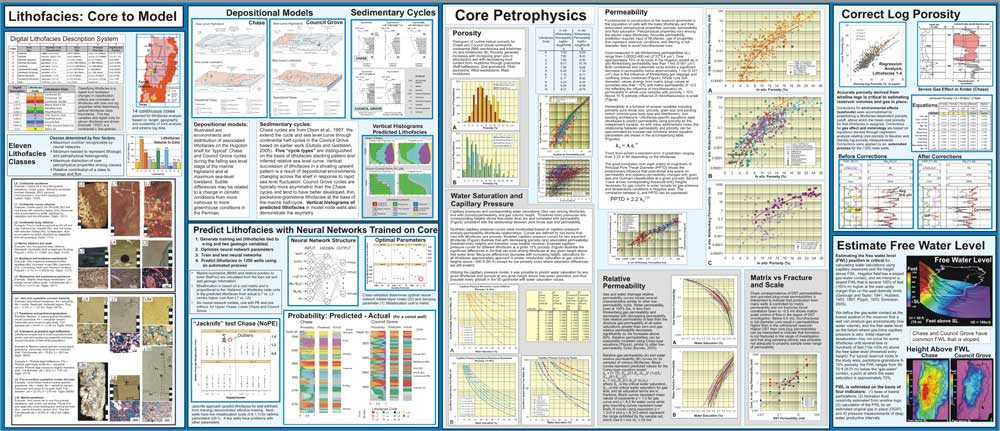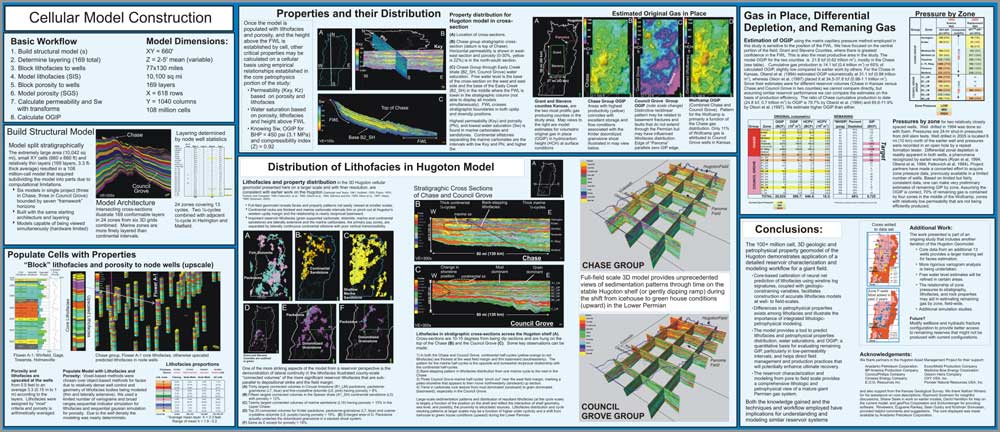|
Multiscale geologic and petrophysical modeling of the giant Hugoton Gas Field (Permian), Kansas and Oklahoma |
Kansas Geological Survey KGS Open-file 2006-12 |
American Association of Petroleum Geologists© AAPG Memoir 88 Giant Hydrocarbon Reservoirs of the World. Reprinted by permission of AAPG whose permission is required for further use.
Multiscale geologic and petrophysical modeling of the giant Hugoton Gas Field (Permian), Kansas and Oklahoma
Martin K. Dubois, Alan P. Byrnes, Geoffrey C. Bohling, and John H. Doveton
Kansas Geological Survey, University of Kansas, Lawrence, Kansas 66047
Abstract
Reservoir characterization and modeling from pore to field scale of the Hugoton Field (central U.S.) provides a comprehensive view of a mature giant Permian gas system and is aiding in defining original gas in place, and the nature and distribution of gas saturation and reservoir properties. Both the knowledge gained and the techniques and workflow employed have implications for understanding and modeling reservoir systems worldwide that have similar geologic age and reservoir architecture (e.g., Gwahar and North fields, Arabian Gulf). The Kansas-Oklahoma portion of the field has yielded 963 billion m3 (34 tcf) gas over a seventy year period from over 12,000 wells. Most remaining gas is in lower permeability pay zones of the 170-meter thick, differentially depleted, layered reservoir system.
The main pay zones represent thirteen shoaling-upward, fourth-order marine-continental cycles, comprising thin-bedded (2-10 meter), marine carbonate mudstone to grainstone and siltstones to very fine sandstones, and have remarkable lateral continuity. They are separated by low reservoir quality eolian and sabkha redbed. Petrophysical properties vary among eleven major lithofacies classes. Neural network procedures, stochastic modeling, and automation facilitated building a detailed full-field 3D 108-million cell cellular reservoir model of the 10,000 mi2 (26,000 km2) area using a four step workflow: 1) define lithofacies in core and correlate to electric log curves (training set), 2) train a neural network and predict lithofacies at non-cored wells, 3) populate a 3D cellular model with lithofacies using stochastic methods, and 4) populate model with lithofacies-specific petrophysical properties and fluid saturations.
Click within poster to bring PDF of Poster (large files 11-19mb each)
Selected References
Asquith, G., and D. Krygowski, 2004, Basic Well Log Analysis (2nd Edition), American Association of Petroleum Geologists, Tulsa, 244 p.
Berg, R. R., 1975, Capillary pressures in stratigraphic traps: AAPG Bulletin, v. 59, p. 939-956.
Boardman, D. R. II, and Merlynd K. Nestell, 2000, Outcrop-based sequence stratigraphy of the Council Grove Group of the Midcontinent: in K. S. Johnson ed., Platform Carbonates in the Southern Midcontinent, 1996 Symposium. Circular 101, Oklahoma Geological Survey, Norman, p. 275-306.
Bohling, G. C., and J. H. Doveton, 2000, Kipling.xla: An Excel Add-in for Nonparametric Regression and Classification, Kansas Geological Survey, http://www.kgs.ku.edu/software/Kipling/Kipling1.html.
Byrnes, A. P., 2003, Aspects of Permeability, Capillary Pressure, and Relative Permeability Properties and Distribution in Low-Permeability Rocks Important to Evaluation, Damage, and Stimulation, Proceedings Rocky Mountain Association of Geologists - Petroleum Systems and Reservoirs of Southwest Wyoming Symposium, Denver, Colorado, September 19, 2003, 12 p.
Byrnes, A. P., Dubois, M. K., Magnuson, M., 2001, Western Tight Gas Carbonates: Comparison of Council Grove Group, Panoma Field, Southwest Kansas and Western Low Permeability Sandstones; 2001 AAPG Annual Convention Official Program, Denver, CO, p. A31.
Caldwell, C. D., 1991, Cyclic Deposition of the Lower Permian, Wolfcampian, Chase Group, Western Guymon-Hugoton Field, Texas County, Oklahoma, in Midcontinent Core Workshop, in W. L. Watney, A. W. Walton, C. G. Caldwell, and M. K. Dubois, organizers, Integrated Studies of Petroleum Reservoirs in the Midcontinent: Midcontinent American Association of Petroleum Geologists Section Meeting, Wichita, Kansas, p. 57-75.
Deutsch, C.V., and A.G. Journel, 1998, Geostatistical Software Library and User's Guide, Oxford University Press, 369 p.
Dubois, M. K., Byrnes, A. P., Bohling, G. C., Seals, S.C., and Doveton, J.H., 2003, Statistically-based lithofacies predictions for 3-D reservoir modeling: examples from the Panoma (Council Grove) Field, Hugoton Embayment, Southwest Kansas (abs): Proceedings AAPG 2003 Annual Convention, Salt Lake City, Utah, v.12, p. A44, and Kansas Geological Survey Open File Report #2003-30, 3 panels, http://www.kgs.ku.edu/PRS/publication/2003/ofr2003-30/index.html (accessed October 10, 2005).
Dubois, M. K., and Goldstein, R.H., 2005, Accommodation Model for Wolfcamp (Permian) Redbeds at the Updip Margin of North America's Largest Onshore Gas Field (abs), Proceedings AAPG 2005 Annual Convention, June 19-21, Calgary, Alberta, Canada, and Kansas Geological Survey Open File Report 2005-25, http://www.kgs.ku.edu/PRS/AAPG2005/2005-25/index.html (accessed December 31, 2005).
Dubois, M. K., A. P. Byrnes, and G. C. Bohling, 2005, Geologic model for the giant Hugoton and Panoma fields: (abs) AAPG Midcontinent Section Meeting, Oklahoma City, Oklahoma,
http://www.kgs.ku.edu/PRS/Poster/2005/MidcontAAPG/index.html (accessed October 10, 2005).
Dunham, R. J., 1962, Classification of carbonate rocks according to depositional texture, in W.E. Ham, ed., Classification of Carbonate Rocks: Tulsa, AAPG Memoir 1, p.108-121.
Dutton, S. P., E. K. Kim, C. L. Broadhead, W. D. Raatz, S. C. Ruppel, and C. Kerans, 2005: Play analysis and digital portfolio of major oil reservoirs in the Permian Basin: Bureau of Economic Geology Reports of Investigations, RI0271, 302 p.
Fetkovitch, M. J., D. JJ. Ebbs Jr., and J. J. Voelker, 1994, Multiwell, multilayer model to evaluate infill-drilling potential in the Oklahoma Hugoton Field: Paper SPE 20778, 65th Annual Technical Conference and Exhibition, New Orleans, La.
Folk, R. L., 1954, The distinction between grain size and mineral composition in sedimentary rock nomenclature: Jour. Geology, v. 62, p 344-359.
Garlough, John L., and Garvin L. Taylor, 1941, Hugoton Gas field, Grant, Haskell, Morton, Stevens, and Seward Counties, Kansas, and Texas County, Oklahoma: in Levorsen, A. I., ed., Stratigraphic Type Oil Fields, AAPG, Tulsa, p. 78-104.
Gaymard, R., and A.Poupon, 1968, Response of neutron and formation density logs in hydrocarbon bearing formations: The Log Analyst, v. IX, no. 5, p. 3 - 12.
George, B. K., C. Torres-Verdin, M. Delshad, R. Sigal, F. Zouioueche, and B. Anderson, 2004, Assessment of in-situ hydrocarbon saturation in the presence of deep invasion and highly saline connate water: Petrophysics, v. 45, no. 2, p. 141-156.
Grammer, G. M., G. P. Eberli, F. S. P. van Buchem, G. M. Stevenson, and P. Homewood, 1996, Application of high-resolution sequence stratigraphy to evaluate lateral variability in outcrop and subsurface; Desert Creek and Ismay intervals, Paradox Basin, in M. W. Longman and M. D, Sonnenfeld, eds., Paleozoic systems of the Rocky Mountain region: Society for Sedimentary Geology, Rocky Mountain Section, p 235-266.
Hastie, T., R. Tibshirani, and J. Friedman, 2001, The Elements of Statistical Learning: Data Mining, Inference, and Prediction, Springer, New York, 533 p.
Hecker, M. T., M. E. Houston, and J. D. Dumas, 1995, Improved completion designs in the Hugoton field utilizing multiple gamma emitting tracers, Paper SPE 30651, SPE annual technical conference and exhibition, Dallas, Texas, p. 223-235.
Hemsell, C. C., 1939, Geology of Hugoton Gas Field of southwestern Kansas: AAPG Bulletin, v. 23, no. 7, p. 1054-1067.
Heyer, J. F., 1999, Reservoir characterization of the Council Grove Group, Texas County, Oklahoma, in D.F. Merriam, ed., Transactions of the American Association of Petroleum Geologists Midcontinent Section Meeting, Wichita, KS, p. 71-82.
Hough, E. W., M. J. Rzasa, and B. B. Wood, 1951, Interfacial tensions at reservoir pressures and temperatures; apparatus and the water-methane system: Petroleum Transaction American Institute of Mechanical Engineering, Tech. Pub. 3019, v. 192, p. 57-60.
Hubbert, M. K., 1953, Entrapment of petroleum under hydrodynamic conditions: AAPG Bulletin, v. 37, p. 1954-2026.
Hubbert, M. K., 1967, Application of hydrodynamics to oil exploration: 7th World Petroleum Congress Proceedings, Mexico City, v. 1B, p. 59-75.
Jennings, H. Y., Jr, and Newman, G.H., 1971, The effect of temperature and pressure on the interfacial tension of water against methane-normal decane mixtures, AIME, v. 251, p. 171-175.
Kluth, C. F, 1986, Plate Tectonics of the Ancestral Rocky Mountains: in J. A. Peterson, ed. AAPG Memoir 41, p. 353-369.
Kluth, C. F., and Coney, 1981, Plate Tectonics of the Ancestral Rocky Mountains: Geology, v. 9, no. 1, p 10-15.
Konnert, G., A. M. Afifi, S. A. Al-Hajri, K. de Groot, A. A. Al Naim, and H. J. Droste, 2001, Paleozoic Stratigraphy and hydrocarbon habitat of the Arabian Plate, in M. W. Downey, J. C., Threet, and W. A. Morgan, eds., Petroleum provinces of the twenty-first century: AAPG Memoir 74, p. 483-515.
Luczaj, J. A. and R. H. Goldstein, 2000, Diagenesis of the Lower Permian Krider Member, southwest Kansas, U.S.A.: fluid-inclusion, U-Pb, and fission-track evidences for reflux dolomitization during latest Permian time, Journal of Sedimentary Research, vol. 70, no. 3, p. 762-773.
Mason, J. W., 1968, Hugoton and Panhandle field, Kansas, Oklahoma and Texas, in W. B. Beebe and B. F. Curtis, eds., Natural Gases of North America, v. 2, AAPG Memoir 9, p. 1539-1547.
Mazzullo, S. J., C. S. Teal, and C. A. Burtnett, 1995, Facies and stratigraphic analysis of cyclothemic strata in the Chase Group (Permian Wolfcampian, south-central Kansas, in N.J. Hyne, ed., Sequence stratigraphy of the mid-continent: Tulsa Geological Society Special Publication no. 4, 1995, p. 217-248.
McGillivray, J. G., and M. I. Husseini, 1992, The Paleozoic petroleum geology of central Arabia: AAPG Bulletin, v. 76, p. 1491-1506.
Oberst, R. J., P. P. Bansal and M. F. Cohen, 1994, 3-D reservoir simulation results of a 25-square mile study area in Kansas Hugoton gas field: Paper SPE 27931, SPE Mid-Continent Gas Symposium, Amarillo, Tx., p. 137-147.
Olson, T. M., J. A. Babcock, and P. D. Wagner, 1996, Geologic controls aon reservoir complexity, Hugoton giant gas field, Kansas, in D. L. Swindler and C. P. Williams, compilers, Transactions of 1995 AAPG Mid-Continent Section Meeting: Mid-Continent Section, p.189-198.
Olson, T. M., Babcock, J. A., Prasad, K. V. K., Boughton, S.D., Wagner, P.D., Franklin, M.K., and Thompson, K.A., 1997, Reservoir characterization of the giant Hugoton Gas Field, Kansas: American Association of Petroleum Geologists Bulletin, v. 81, p. 1785-1803.
Olszewski, T.D. and M.E. Patzkowsky, 2003, From cyclothems to sequences: The record of eustacy and climate one an icehouse eperic platform (Pennsylvanian-Permian, North American Midcontinent: Journal of Sedimentary research, v. 73, no. 1, p. 15-30.
Parham, K. D., and J. A. Campbell, 1993, PM-8. Wolfcampian shallow shelf carbonate-Hugoton Embayment, Kansas and Oklahoma: in D. G. Bebout, ed., Atlas of Major Midcontinent Gas Reservoirs, Gas Research Institute, p. 9-12.
Parrish, J. T., 1995, Geologic evidence of Permian climate: in P.A. Scholle, T.M. Peryt, and D.S. Ulmer-Scholle, ed., The Permian of northern Pangea, Volume I; Paleogeography, paleoclimate, Stratigraphy, p. 53-61.
Parrish, J. T. and E. Peterson, 1988, Wind Directions Predicted from Global Circulation Models and Wind Directions Determined from Eolian Sandstones of the Western United States - A Comparison: sedimentary, Geology, v. 56, p. 261-282.
Perry, W. J., 1989, Tectonic evolution of the Anadarko basin region, Oklhaoma: U.S. Geological Survey Bulletin 1866-A, p. A1-16.
Pippin, L., 1970, Panhandle-Hugoton Field, Texas-Oklahoma-Kansas-The First Fifty Years. in Halbouty, Michel T. (ed.), Geology of Giant Petroleum Fields. AAPG Memoir 14, Tulsa, p. 204-222.
Puckette, G.R., D.R. Boardman, II, and Z. Al-Shaieb, 1995, Evidence for sea-level fluctuation and stratigraphic sequences in the Council Grove Group (Lower Permian) Hugoton Embayment, southern Mid continent, in N.J. Hyne, ed., Sequence Stratigraphy of the Mid-Continent, Tulsa Geological Society Special Publication no. 4, p. 269-290.
Purcell, W. R., 1949, Capillary pressure - their measurements using mercury and the calculation of permeability therefrom: American Institute of Mechanical Engineers Petroleum Transactions, v. 186, p. 39-48.
R Development Core Team (2005). R: A language and environment for statistical computing. R Foundation for Statistical Computing, Vienna, Austria, http://www.R-project.org.
Rankey, E. C., 1997, Relations between relative changes in sea level and climate shifts; Pennsylvanian-Permian mixed carbonate-siliciclastic strata, western United States, Geological Society of America, Bulletin, vol. 109, no. 9, p. 1089-1100.
Rascoe, B., Jr., 1968, Permian System in Western Midcontinent: Mountain Geologist, v. 5, p. 127-138.
Rascoe, B., Jr., and F. J. Adler, 1983, Permo-Carboniferous Hydrocarbon Accumulations, Midcontinent, USA: American Association of Petroleum Geologists Bulletin, v. 67, p. 979-1001.
Ryan, T. C., m. J. Sweeney, and W. H. Jamieson Jr., 1994, Individual layer transient tests in low-pressure, multi-layered reservoirs: Paper SPE 27928, SPE Mid-Continent Gas Symposium, Amarillo, Texas, p. 99-113.
Siemers, W. T., and W. M. Ahr, 1990, Reservoir facies, pore characteristics, and flow units: Lower Permian Chase Group, Guymon-Hugoton Field, Oklahoma, Society of Petroleum Engineers proceedings 65th Annual Technical Conference and Exhibition, New Orleans, LA, September 23-26, 1990, p. 417-428, SPE #20757.
Soreghan, G. S., 2002, Sedimentalogic-magnetic record of western Pangean climate in upper Paleozoic loessites (lower Cutler beds, Utah): Geological Society of America Bulletin, v. 114, no. 8, p.1019-1035.
Sorenson, R. P., 2005, A dynamic model for the Permian Panhandle and Hugoton fields, western Anadarko basin: AAPG Bulletin, vol. 89, no. 7, p. 921-938.
Venables, W. N., and B. D. Ripley, 2002, Modern Applied Statistics with S, Fourth Edition, Springer, New York, 512 p.
Washburn, E. W., 1921, A method of determining the distribution of pore sizes in a porous material: Proceedings of the National Academy of Sciences, v. 7, p. 115-116
Weber, L. J., F. M. Wright, J. F. Sarg, E. Shaw, L. P. Harman, J. B., Vanderhill, and D. A. Best, 1994, Reservoir delineation and performance; application of sequence stratigraphy and integration of petrophysics and engineering data, Aneth Field, Southeast Utah, U.S.A.: in E. L. Stout and P. M. Harris, eds., Hydrocarbon reservoir characterization; geologic framework and flow unit modeling: Society of Sedimentary Geology, Tulsa, OK, p. 1-29.
Winters, N. D., M. K. Dubois, and T. R. Carr, 2005, Depositional model and distribution of marginal marine sands in the Chase Group, Hugoton Gas field, southwest Kansas and Oklahoma Panhandle: (abs) AAPG Midcontinent Section Meeting, Oklahoma City, Oklahoma,
http://www.kgs.ku.edu/PRS/Poster/2005/MidcontAAPG/index.html (accessed October 10, 2005).


